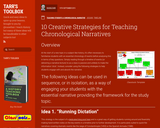
This resource provides instructional strategies for teaching chronological narratives.
- Subject:
- Social Studies
- Material Type:
- Activity/Lab
- Provider:
- Tarr's Toolbox
- Date Added:
- 08/17/2017

This resource provides instructional strategies for teaching chronological narratives.
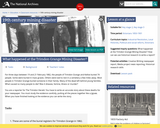
This inquiry-led lesson guides students through writing a newspaper article about a mining accident in Trimdon Grange, discussing its causes, its consequences, and the impact on life in the town and elsewhere.

This parent guide supports parents in helping their child at home with the 8th grade Social Studies content.

This resource accompanies our Rethink 8th Grade Social Studies course. It includes ideas for use, ways to support exceptional children, ways to extend learning, digital resources and tools, tips for supporting English Language Learners and students with visual and hearing impairments. There are also ideas for offline learning.

Containing more than 50 articles from the award-winning Tar Heel Junior Historian magazine and over 40 lesson plans, this multidisciplinary Educator Notebook will enrich your exploration of North Carolina and American history with diverse perspectives. This resource's link takes you to a very short form that gives you free downloadable access to the complete PDF book.

Birth of a Colony explores the history of North Carolina from the time of European exploration through the Tuscarora War. Presented in five acts, the video combines primary sources and expert commentary to bring this period of our history to life. The accompanying teacher guides provide lesson activity ideas, vocabulary, and additional reading resources to compliment each act's theme. The 5 act themes are: First on the Land, The Road to Zacatecas, The Roanoke Voyages, A New Voyage to North Carolina, and , The Tuscarora War.

Birth of a Colony explores the history of North Carolina from the time of European exploration through the Tuscarora War. Presented in five acts, the video combines primary sources and expert commentary to bring this period of our history to life. Act II of Birth of a Colony focuses on the Spanish exploration and exploitation of the New World and the attempt to find a new route to Zacatecas. Vast wealth from silver enabled Spain to finance more exploration and expand its empire. In an effort to defend Spanish trade and protect Spain?s investment in the mines, King Philip II launched an attempt to establish a colony in North America. This teacher's guide contains 2 SS lessons plans: Finding a Lost Spanish Fort; Mapping Juan Pardo. Additional suggested resources are also included. The Birth of a Colony video can be accessed at the following link: http://video.unctv.org/video/2149619983/ The referenced article can be accessed at the following link: http://www.ncmuseumofhistory.org/collateral/articles/F07.lost.spanish.fort.pdf

Birth of a Colony explores the history of North Carolina from the time of European exploration through the Tuscarora War. Presented in five acts, the video combines primary sources and expert commentary to bring this period of our history to life. Act IV of Birth of a Colony is divided into three parts. The first part explores the development of permanent English settlements in North Carolina. The second part of this segment focuses on the establishment of a proprietary colony in Carolina. The The third part of this segment focuses on the journey of John Lawson from Charleston, through the interior sections of the Piedmont, to the Pamlico Sound. This teacher's guide includes 2 SS lessons: John Lawson, Surveyor; Teaching the Carolina Charter. Additional suggested resources and optional extension activities are also included. The Birth of a Colony video can be accessed at the following link: http://video.unctv.org/video/2149619983/

This inquiry provides students with an opportunity to explore how words affect public opinion through an examination of Harriet Beecher Stowe's novel Uncle Tom's Cabin. Students will investigate historical sources related to the novel and reactions of people in the North and South in order to address the compelling question "Can words lead to war?" The final summative assessment asks the to make an argument about the impact of the words in Uncle Tom's Cabin.

In this lesson, students will review and summarize questions about the struggle for equality and apply them to other civil rights struggles. Students will also devise a timeline regarding other civil rights struggles.

This virtual field trip from Historic Bath State Site is a fun way to learn more about a kid's life in the 18th century. The field trip packet contains ,links to YouTube videos of costumed interpreters demonstrating historic activities, pre- and post-watch content for educators that provide context and engagement, and follow-up activities (games, crafts, and coloring pages). Live Q&A can be booked as part of the field trip as well.

In this lesson, students explore major events occurring at the end of World War II, including the bombing of Pearl Harbor, the forced relocation of Japanese Americans into internment camps, and America’s use of atomic weapons against Hiroshima and Nagasaki. Students will explore primary sources, read poetry and a narrative, and discuss the US government’s choices in depth while examining the affect on America, Japan, and the world community at large.

Students will analyze documents pertaining to the woman suffrage movement as it intensified following passage of the 15th Amendment that guaranteed the right to vote for African American males. Documents were chosen to call attention to the struggle's length, the movement's techniques, and the variety of arguments for and against giving women the vote.

Students will explore the Articles of Confederation and the Articles' influence in revising the Constitution of 1787. Students will experience the sentiments of Federalists and Anti Federalists by participating in a partner debate as either North Carolina Federalist James Iredell or Anti Federalist Willie Jones.
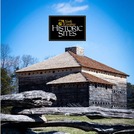
Fort Dobbs has created a series of short videos designed to teach students about the settlement of the Northwest Carolina backcountry, the lives of the Native Americans living in and near the region of Fort Dobbs, the life of a North Carolina Provincial Soldier, and North Carolina's role during the French and Indian War. The videos are designed for teachers to use them separately to fit into their own lessons or can be grouped together by theme.
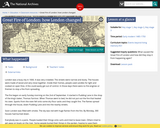
This lesson discusses the Great Fire of London in 1666 and its causes as well as its repercussions long after.

In this lesson, students learn about the conditions of African Americans in Mississippi during the summer of 1964 through reading excerpts from the Benton County Freedom Train newsletter. Students will then use the graphic/comic creation site Pixton.com to create a graphic strip of three or more panels to demonstrate their understanding of the excerpts.

In this inquiry, students investigate the interaction between the Pilgrims and the Wampanoags that incuded the first Thanksgiving. The compelling question focuses on how the relationship between Native Americans and European settlers deteriorated over time.

In this lesson, students will discuss the concept of democracy and through this lens, analyze the unjust Jim Crow laws that dominated the South. Through discussion, readings and the examination of primary sources, students will gain an understanding of how the period immediately following World War II set the stage for numerous challenges to Jim Crow, one of which was the 1947 Journey of Reconciliation. Students will culminate this lesson by creating a historical marker that honors the Journey of Reconciliation’s riders and educates the public about this important period of history.
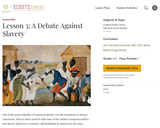
Sometimes, people will fight to keep someone else from being treated poorly. Disagreement over slavery was central to the conflict between the North and the South. The nation was deeply divided.